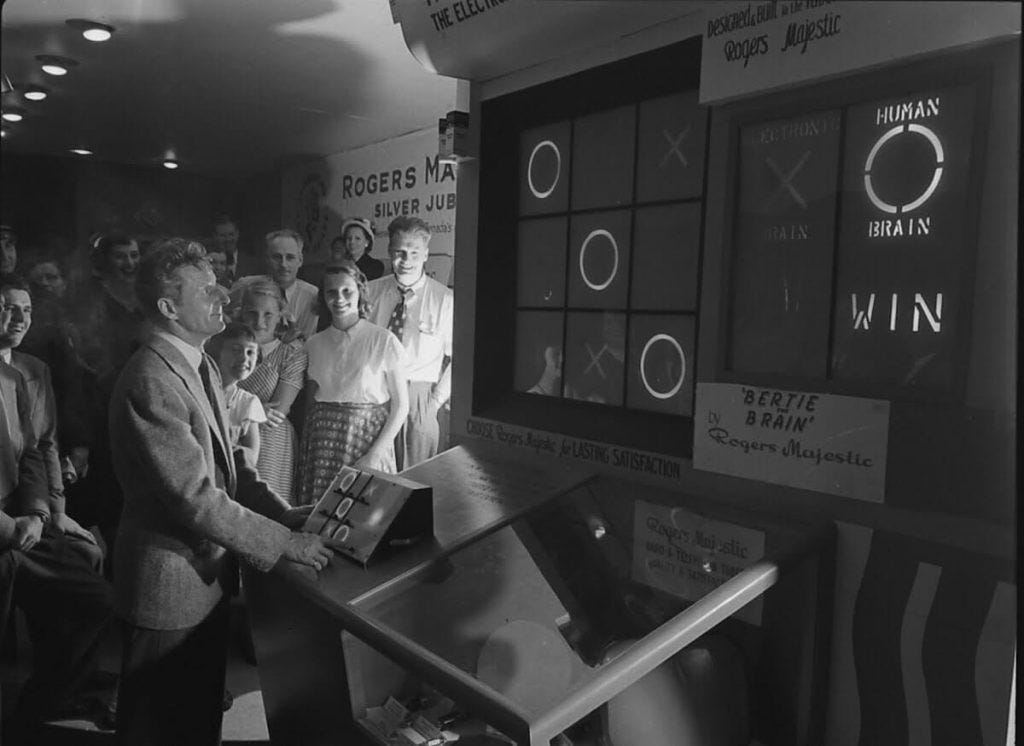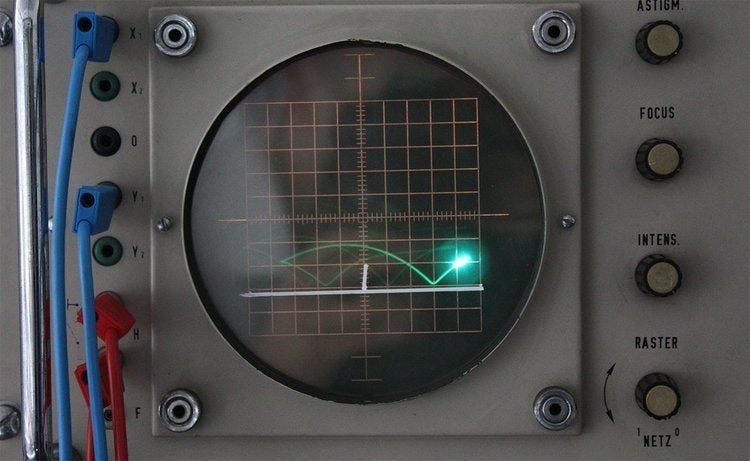The 50 Years of Text Games book begins its game coverage in 1971, but that’s not where the book starts. A lengthy introduction covers the prehistory of digital games you could type to, which stretches back further than you might think. I'm happy to debut an excerpt from the book’s opening pages about the dawn of interactive text.
When could you first type words into a computer and get words back in return? Like many firsts, it’s difficult to pinpoint with certainty. In their earliest decades, computers evolved so quickly that many innovations were made and lost and made again before spreading far enough to be standardized: each installation was bespoke with its own hardware, tools, and code.

While computers had been hooked up to typewriters from the very beginning—even the punch card output of the ENIAC, progenitor of the twentieth-century computer revolution, could be fed into a tabulator to render its results into more human-readable form—sending complex input back into the computer via keyboard was trickier. By the second half of the 1950s, projects like Grace Hopper's FLOW-MATIC were tackling the challenge; but computers, and even computer games, had been around for years by then.
In fact, despite the legend, computer games with graphics came before computer games with text. It was language—storing it, assembling it, understanding it—that, at first, was hard.

The earliest digital games used mothballed World War II radar displays, oscilloscopes, or grids of blinking lights for their graphics. In 1947, two New Jersey physicists submitted a patent for a Cathode-Ray Tube Amusement Device, which let the player shape arcs of curved light on a screen. The beams signified the paths of virtual artillery shells, and plastic airplane decals attached to the screen showed the position of targets. If the player could align their beam with a target, they scored. Though it never moved beyond the prototype phase, even this early game had flashy graphics. On a hit, a clever engineering trick forced a resistor overload, causing the display to briefly lose focus and the bright dot of the missile to blur into a fuzzy circle—a tiny expanding explosion.
People were playing with cathode ray tubes on the other side of the Atlantic too. A technology developed in England—the Williams-Kilburn tube, after its two inventors—could both store and display persistent binary data using a grid of visible dots. By reading the location of the brightened phosphors (which represented ones) and looping back a signal to keep them lit, the tube could “store” the very data it was displaying. The technology opened up a relatively inexpensive way to give a computer random-access memory, using the electrical signal to determine whether the phosphor dot at a given position was bright or dim.
The visible grid of bits could give human operators an invaluable window into a running program, but it also gave them a canvas. In 1947, Williams and Kilburn configured their prototype to display the blocky words “C.R.T. STORE,” perhaps the first bitmapped text ever drawn to a screen.

The two engineers developed a computer that could use their memory tube: the Manchester Baby, the first stored program computer. In a later incarnation, the Ferranti Mark 1, it also became one of the first computers to be commercially sold (albeit to institutions, at a cost more akin to a house than an appliance).
One of the earliest software games without dedicated hardware was devised for the Ferranti, first running successfully in 1952. It played a game of draughts (checkers), using the grid of phosphor dots on one of its small round Williams-Kilburn screens to draw the board and pieces. (Noah Wardrip-Fruin has dubbed this previously unnamed game M.U.C. Draughts, after the system’s informal name: the Manchester University Computer.)

But the program could also output text to an attached teletypewriter, making it likely the earliest digital game to print full sentences. On startup, the machine would print:
PLEASE READ THE INSTRUCTION CARD.
This was necessary because playing moves meant inputting a series of 5-bit numbers via a long row of switches—the computer could print English text more easily than it could receive it. After the user learned from the card that they needed to press a particular button on the console to proceed, the printer continued:
SHALL WE TOSS FOR THE FIRST MOVE? WILL YOU SPIN A COIN? TAILS
HAVE I WON?
Once the player answered, the game could begin.
While moves were primarily shown visually on the CRT grid, the program would use the teletype to offer occasional feedback, which could get testy if the human took too long to move or entered incorrect data:
YOU MUST PLAY AT ONCE OR RESIGN.
KINDLY READ THE INSTRUCTIONS AND START THE MOVE AGAIN.
I REFUSE TO WASTE ANY MORE TIME. GO AND PLAY WITH A HUMAN BEING/.
(The /. at the end of the last line may have signified an exclamation mark, since the teleprinter hooked up to the Ferranti Mark 1 had no such dedicated symbol.)
The text, and the rather clever draughts-playing program itself, were written by an unlikely programmer named Christopher Strachey. A brilliant mathematician, Strachey had suffered a nervous breakdown halfway through his undergraduate coursework, later attributed by his sister to a struggle to reconcile his sexuality with the rigidly heteronormative world of the 1940s. Though he returned to finish his degree, he did not test well enough to continue on to graduate work and settled instead into a quiet life as a schoolteacher. But one of his college chums had been computing pioneer Alan Turing, and years later, idly curious, Strachey was able to get access to the Manchester computer through his old acquaintance.
Strachey threw himself into the extraordinary challenge of programming early computers with an almost obsessive passion. A famous anecdote tells that he asked Turing for ideas: what should he write for his first program? Without cracking a smile, Turing suggested he write some code to make the computer simulate itself. Not knowing the task would be extraordinarily difficult, Strachey nevertheless came back some weeks later with a program not only far longer than any yet written for the machine, but one that ran correctly and played “God Save the King” through the system’s alert speaker when it finished—incidentally, one of the earliest pieces of computer music. Turing, refusing to be drawn out, responded only by muttering, “Good show.”
After teaching the Manchester University Computer to play draughts, Strachey next programmed it to print out procedurally generated love letters. His code filled in template sentences with random words from a list of flowery adjectives, entered one tedious character at a time into the machine. Strachey pinned the printed love notes anonymously to the department’s notice board, to the consternation of colleagues:
HONEY DEAR
MY SYMPATHETIC AFFECTION BEAUTIFULLY ATTRACTS YOUR
AFFECTIONATE ENTHUSIASM. YOU ARE MY LOVING ADORATION: MY BREATHLESS ADORATION. MY FELLOW FEELING BREATHLESSLY HOPES FOR YOUR DEAR EAGERNESS. MY LOVESICK ADORATION CHERISHES YOUR AVID ARDOUR.
YOURS WISTFULLY
M. U. C.
Strachey had a unique ability to see before others how computers might be used, as well as misused. When Joseph Weizenbaum’s chatbot ELIZA led to widespread alarm and misunderstanding about its capabilities in the late 1960s, its creator had foreseen the cultural disconnect, writing:
Machines are made to behave in wondrous ways often sufficient to dazzle even the most experienced observer. But once a particular program is unmasked, once its inner workings are explained in language sufficiently plain to induce understanding, its magic crumbles away; it stands revealed as a mere collection of procedures.
Christopher Strachey had expressed almost exactly the same sentiment more than a decade earlier, writing of his draughts-playing and romance-penning programs:
The whole behaviour of the machine, though perfectly determinate and simple if you know the rules, appears to the uninitiated as complex and unpredictable.… [These kinds of programs] are, of course, the most spectacular examples and ones which are easily understood by laymen. As a consequence they get much more publicity—and generally very inaccurate publicity at that—than perhaps they deserve.
Strachey would go on to a long career as a computer scientist, pioneering many ideas in programming language design and time-sharing architecture. He was one of the very first software developers, and one of the earliest authors of prose meant for computers to perform. Twenty-five years before Crowther and Woods, he became godfather to all text games in the decades to come.
If you enjoyed this article, check out the 50 Years of Text Games book, an in-depth look at the history of text-based computer games.




Fascinating.
Brilliant article! You prompted me to find more about Strachey. And like Fos13, I'm eagerly awaiting my copy :-)